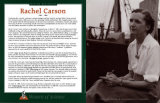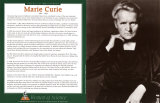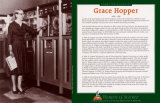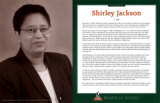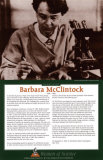|
|
|
Jocelyn Bell Burnell
b. 7-15-1943; Belfast, Northern Ireland
Astronomer and physicist Jocelyn Bell Burnell discovered a new kind of star in our galaxy, the Milky Way. Her findings opened up many new areas of research in astronomy and related fields.
Susan Jocelyn Bell was born July 15, 1943, in Belfast, Northern Ireland. Her family supported her love of learning, and she moved to England to attend a boarding school for her high school years. Despite the lack of science equipment at the all-girl school, a wonderful teacher inspired her interest in physics – the science of matter and energy and how these forces interact with each other.
She entered Glasgow University in Scotland and earned a degree in physics in 1965. She then began working toward a more advanced degree at Cambridge University in England under Anthony Hewish. Dr. Hewish had designed a large radio telescope to study quasars – star-like objects that give off radio waves. Ms. Bell helped build that telescope, which covered nearly five acres of ground and used over 1,000 posts with 120 miles of wire and cables strung among them. Once it began working in 1967, Ms. Bell operated the radio telescope and analyzed its findings. This information filled 96 feet of chart paper every day.
Later that year, she noticed unusual markings on the charts that showed radio signals unlike any that anyone had seen before. The charts showed the signals came every 11/4 seconds, far too fast to come from an object as large as a star. She informed Professor Hewish of her findings. After ruling out the possibility that the signals came from some manmade source, they wondered if the signals might be coming from aliens. Ms. Bell even began to call them LGM signals, for “Little Green Men.” However, she soon found another signal, coming from the other side of the sky every 11/2 seconds.
Ms. Bell had discovered pulsars, which are dense, spinning stars that send out radio waves as they rotate, something like lighthouse beacons. She and Dr. Hewish announced their findings, starting a a storm of media attention and debate. Soon, other scientists showed that pulsars could be a type of extremely heavy, dense, small star called a neutron star. Before this, scientists had guessed that there were neutron stars, but Ms. Bell's discovery was the first evidence that proved they exist.
Ms. Bell soon finished her Ph.D. and married Martin Burnell. Her husband's career required them to move frequently, and she found jobs in physics wherever they moved. Dr. Burnell went on to study many kinds of rays, or waves of energy that stars give off, including gamma rays, x-rays, and infrard rays. In 1974, her advisor Anthony Hewish was awarded the Nobel Prize in Physics for the discovery of pulsars, a prize the Dr. Burnell did not share because she was a graduate student at the time of the discovery. Some well-known astronomers argued that she should have shared the Nobel. She is now head of the physics department at Open University in Great Britain.
(Bell-Burnell is very active in the Quaker Peace and Social Witness organization promoting and practicing equality, justice, peace, simplicity and truth.)
• Inventions - Telescope poster
|
|
|
|
Rachel Carson, Marine Biologist
b. 5-27-1907; Springdale, Pennsylvania
d. 4-14-1964
Combine her scientific training as a maritime biologist and her talent for writing, Rachel Carson warned that chamicals made to kill insects were also poisoning wildlife and humans. She cahnged people's views of the natural world by showing humans as one part of an ecosystem, a community of plants and anilas interacting with their surroundings and all connected to and dependent on eash other. Her work helped statrt the modern movement to protect the environment.
Rachel Louise Carson was born in Springdale, Pennsylvanian, on May 27, 1907, and she spent much of her childhood writing and exploring the outdoors. When she was 10, a story of hers was published in a chlldren's magazine. She entered Pennsylvania Collge for Women, now called Chatham College, as an English major. However, she changed her major to zoology after taking science classes with an inspiring biology teacher. She graduated in 1929 and spent six weeks studying at Woods Hole Marine Biological Laboratory in Massachusetts. She taught zoology at the University of Maryland while earning an advanced degree in marine biolgoy at Johns Hopkins University in Baltimore.
In 1955 the U.S. Bureau of Fisheries, which later became part of the Fish and Wildlife Service, hired Ms. Carson to write pamplets and articles about marine life. She quickly became an official aquatic biologist there. In 1936, the magazine Atlantic Monthly printed one of her essays, “Undersea.” A publisher, impressed by the essay, asked her to write her first book.
In 1958, Ms. Carson got a letter from her friend Olga Owens Huckins. Ms. Huckins angrily reported that a pesticide the government used to kill mosquitoes had also killed birds on her land. Ms. Carson decided to research this chemical, called DDT, and spent the next four years preparing a book on the problems of pesticide use. Her book Silent Spring detailed how pesticides that killed insects also poisoned fish, birds, and humans. Published in 1962, Silent Spring set off intense reactions. The chemical industry defended its products and attacked the book and Ms. Carson. But the book lead many people to realize the possible dangers of human impact on the owrld and helped spark the environmental movement.
Great public interest prompted the governemnt to act. President John F. Kennedy announced that his Science Advosry Committee would investigate pesticide use, and the committee's report agreed with Ms. Carson's findings. In 1963, Ms. Carson testified before Congress about the issue.
On April 14, 1964 Rachel Carson died at age 56 after a long battle with cancer. In 1972, thanks in large part to Silent Spring, DDT was banned in the United States. In 1980, Ms. Carson, was awarded the Presidential Medal of Freedom, the highest civilian award in the U.S.
• Rachel Carson posters
• more notable ecologists posters
|
|
|
|
Marie Curie
b. 11-7-1867; Warsaw, Poland
d. 7-4-1934; Paris, France
Poster Text: The pioneering reasearch of physicist and chemist Marie Curie contributed to some of the most important new fields of study in science, from modern physics to the treatment of cancer. Madame Curie was the first woman to be awarded a Nobel Prize, the most famous honor in science. Eventually she won two Nobels.
On November 7, 1867, Marya Sklodowska was born in Warsaw, Poland. Her father, a professor of mathematics and physics, sparked her interest in science. After graduating from high school, she began working as a tutor and governess to earn money so she could fulfill her dream of attending the Sorbonne, a university in Paris.
In 1891 she moved to France and began studying at the Sorbonne, registering as Marie, the French version of her name. In just two years she earned a degree in physics, and went on to earn a second degree in mathematics in another year. She met Pierre Curie, a well-known and respected physicist, in 1894, and they married the following year.
Another French physicist, Antoine Bacquerel had recently discovered that a metal called uranium let off rays of energy that no one understood. Madame Curie decided to study these rays. Her research soon revealed that this energy which she named “radioactivity,” came from within the atom itself. An atom is the smallest particle of a simple chemical substance called an element. In 1898 her husband joind her in this research, and working with tons of uranium ore, they separated out two new radioactive elements. They named these elements polonium, after Madame Curie's native Poland, and radium.
In 1906, Pierre Curie was hit by a truck and killed. Madame Curie took up his professorship at the Sorbonne becoming the first woman ever to teach there. She carried on her research of radium, and in 1911 she was awarded the Nobel Prize in Chemistry for separating out radium and studying its chemical properties. Madame Curie helped found the Radium Institute in Paris in 1914 and served as its first director. This center, where doctors use radiation to treat cancer and researchers study chemistry and biology, was later renamed the Curie Institute.
Radium can be used to take an x-ray. After the outbreak of World War I, Madame Curie helped set up x-ray machines in vans that could be taken out to help doctors treat the wounded.
Although no one knew it at that time, radiation can make people very ill. Both Pierre and Marie Curie sufferd bad health effects from what is now known as radiation sickness. On July 4, 1934, Marie Curie died of leukemia, most likely brought on by exposure to radiation during her work. Her daugher, Irene Joliot-Curie, and her son-in-law continued research in the same field, and the two of them were awared the Nobel Prize in Chemistry in 1935 for producing new radioactive elements.
• more Marie Curie posters
|
|
|
|
Jane Goodall, Ethologist
b. 4-3-1934; London, England
Zoologist and animal behavorist Jane Goodall has risen to world-wide fame conducting one of the first long-term studies of an animal in its environment. Observing chimpanzees in the wilds of Africa, she has found that chimps have complicated connections with teach other, much as humans do. Her adventures and discoveries have inspired many researchers and conservationists.
Born in London, England, on April 3, 1934, Jane grew up in Bournemouth, on England's southern coast. As a little girl she was fascinated by animals, both watching and reading about them. When she grew older, she took an important step toward what eould be her life's work. A friend who had moved to Africa invited her to visit. Ms. Goodall worked as a waitress to save up money for the trip, and in 1957 boarded a boat for Kenya.
While she was there she heard about the anthropologist Louis Leakey, who was in Africa searching for clues to our human ancestors. Ms. Goodall arranged to meet Dr. Leakey and told him about her interests. He hired her as an assistant and she accopanied him and his wife, Mary Leakey, to look for human fossils. Louis Leakey encouraged her to begin a study of chimpanzees, a close relative to humans, as a way to search for clues about the behavior of early haumans. Ms. Goodall had some trouble getting permission to live alone in Africa as a single woman. Finally, in 1960, Jane Goodall and her mother traveled to Gombe National Park in what is now Tanzania to study chimpansee.
In the beginning, the chimps hid from Ms. Goodall as she tried to study them. She first watched them through binoculars. But over time, the chimps got used to her. They allowed her to get close to them, and she followed them to observe their behavior. In the course of her work she made some amazing and important discoveries. While scientists had long thought chimps were vegetarians, Ms Goodall discovered they sometimes killed and ate animals, such as monkeys. She noticed that much of their behavior – things like hugging and tickling – often looked like human behavior. Perhaps her most important finding came when she saw chimps making and using tools. At the time scientists thought only humans had the brainpower to make and use tools.
In 1965, Ms. Goodall earned her Ph.D. in ethology, the study of animal behavior, from Cambridge University in England. Dr. Goodall is one of the few people ever to earn such an advanced degree without first completing four or more years of college.
She returned to Africa and established the Gombe Stream Research Centre, which hosts one of the longest-running field studies of an animal in its habitat. Dr. Goodall has written several books for adults, including the best sellers In the Shadow of Man. Her books, magazine articles, and a National Geographic documentary on her findings helpe make her famous.
In 1977 she founded the Jane Goodall Institute, which works to protect chimps, who numbers are falling, as well as other animals and the environment. Dr. Goodall spends much of her time traveling to lecture and promote chimpanzee conservation and environmental education.
• Women of Science composite poster
|
|
|
|
Grace Hopper
b. 12-9-1906; NYC
d. 1-1-1992; Arlington, VA
Any list of the great leaders in the field of computer science must include Rear Admiral Dr. Grace Murray Hopper. She programmed some of the first computers, helped develop important software and new computer languages, and paved the way for modern information processing.
Grace Brewster Murray was born December 9, 1906, in New York City. Early on, she showed an interest in learning how things worked, she even took apart the alarm clocks in her house. She graduated from Vassar College with a degree in math and physics in 1928. She became an instructor at Vassar and married Vincent Foster Hopper in 1930. While she was teaching she continued her own studies, earning a Ph.D. in mathermatics from Yale University in 1934.
In 1943, Dr. Hopper joined the United States Naval Reserves because she wanted to serve her country during World War II. In 1944, whe went to Harvard to work on the Bureau of Ordnance Computation Project, which was using an early digital computer to figure the angle at which naval guns should be fired in different kinds of weather. The computer was known as the Mark I, and it was 51 feet long. After the war, Dr. Hopper was discharged from active duty but remained a Navy reservist and stayed at Harvard, working on the Mark II and Mark III computers. One day, the Mark II suddenly stopped working. When she went to look for the problem, Dr. Hopper found that a moth had gotten trapped inside the huge computer. She put the moth in her log book as the first time a “bug” and been found in a computer. Her term for a computer malfunction is still used today.
In 1949, Dr. Hopper left Harvard to join the Eckert-Mauchly Computer Corporation as a senior mathematician working on UNIVAC 1, the first large-scale electronic digital computer. There she developed her first computer, which translates mathematical codes or symbols into computer language. At the time Dr. Hopper began work on UNIVAC 1, computer languages were so complicated only scientists of full-time programmers could use and understand them. To make computers available to more people Dr. Hopper began to develop a program known as FLOW-MATIC that let the computer recognize words in English. The program was designed to help businesses with such tasks as billing and payroll calculations. Her FLOW-MATIC provide a basis for a new universal language called Common Business Oriented Language, or COBOL. Dr. Hopper advised the group that developed this important standard language and helped create COBOL manuals and tools.
In 1966 she retired from the Navy, but within seven months she was called back to work on the Navy's computer system. When Rear Admiral Hopper finally retired from the Navy in 1986, she was the nation's oldest active duty officer. She then became a consultant to Digital Equipment Corporation. Throughout her life she taught as a professor and traveled widely to give lectures. Among her many honors, she was the first person ever awarded the Computer Sciences “Man of the Year” Award. She died on January 1, 1992, in Arlington, Virginia.
• Grace Hopper posters
• Women of Science composite poster
|
|
|
|
Shirley Jackson, Physicist
b. 8-5-1946; Washington, DC
Physicist Dr. Shirley Jackson has been recognized not only for her scientific research but for pursuing an education and career in a profession that wasn't always open to women and minorities. Despite obstacles, she became one of the first African-American women scientists to reach the top of her field.
Shirley Ann Jackson was born August 5, 1946, in Washington, D.C. As a child, her family encouraged her interest in science, allowing her to keep bees under their back porch so she could carry out experiments. In 1964, she graduated s valedictorian from her high school and entered the Massachusetts Institute of Technology (MIT). One of only two African American women in the class of 900, whe earned a degree in physics in 1968. During this time she organized the Black Student Union at the school, which helped increase the number of African American students enrolling there.
In 1973, she became the first African American woman to earn a Ph.D. in any field from MIT. Dr. Jackson received a Ph.D. in theoretical particle physics, which deals with the basic, tiny particles that join together in different ways to make up an atom. Atoms are the smallest units of the simple chemicals called elements. Scientist study how these particles interact with each other to better understand why materials behave the way they do.
After graduation, Dr. Jackson held research positions both at home and abroad, including at the Fermi National Accelerator Laboratory in Illinois and the European Organization for Nuclear Research in Switzerland. In 1976, she became a researcher at AT&T Bell Laboratories in New Jersey. There she worked in several different branches of physics. Her research mainly focused on condensed matter theory, a type of physics that looks at how solid substances are affected by forces like temperature and pressure. Dr. Jackson studied the effects of electricity and light on solids. Her work involved semiconductors, whch are vital to making modern computers, radios, TVs and other electronic devices.
In 1991, Dr. Jackson became a professor of physics at Rutgers University, but remained as a consultant on semiconductors for Bell Labs. She taught until 1995, when President Bill Clinton chose her to be a member of the United States Nuclear Regulatory Commission. This group is responsible for all non-military use of nuclear energy in the U.S. including the licensing and safety of nuclear power plants, nuclear medicine, and the storage of nuclear waste. Two month after she joined the commission she became its chairperson – the first woman and the first African American to hold this office.
Dr. Jackson left the commission in 1999 to become president of Rensselaer Polytechnic Institute, a major research university. She is the first African American woman to hold such a post in the United States.
• Strong Force: The Story of Physicist Shirley Ann Jackson
|
|
|
|
Mary Leakey, Anthropologist
b. 2-6-1913; London, England
d. 12-9-1996; Nairobi, Kenya, East Africa
Anthropologists study the origins and development of humankind. As a member of a family of famous anthropologists, Mary Leaky found some of the most important fossils, tools, and other records of early humans in Africa. Her discoveries helped shape our undertanding of the origins of human beings.
Mary Douglas Nicol was born February 6, 1913, in London, England. She spent a good deal of time traveling to different countries while she was growing up, and when her father took her to see prehistoric cave painting in France, it sparked in her a lifelong interest in prehistory and archaeology. She attended lectures at the London Museum and the University of London, but never formally enrolled in college. She also worked with archaeological expeditions in Great Britain.
In 1933, she met archaeologist and anthropologist Louis Leakey. Impressed by her drawing skills, he asked her to illustrate a book of his. She traveled to Africa, and in 1935 began working with him in the field. The two married the following year. The Leakeys worked in Kenya and Tanzania for many years, but success came slowly. In 1945, Ms. Leakey made her first big find, the 16-million-year-old skull and facial bones of a hominid called “Proconsul africanus.” which is an ape-like ancestor of both apes and early humans. Anthropologists thought it could ve a “missing link”: a primate that could fill the gap in the fossil record between apes and early humans.
Eleven years later, Mary Leakey made another find that propelled the Leakeys to fame. In 1959, near the Olduvai Gorge in Africa, she uncovered a 1.8-million-year-old hominid skull that Louis Leakey called “Zinjanthropus” and that was later renamed “Australopithecus boisei.” This discovery provided some of the first evidence that human ancestors lived in Africa, and they lived there at a much earlier date than previously thought. The National Geographic Society reported the discovery, which drew wide public interest. The Society then began funding the Leakeys' research.
During her career, Mary Leakey made many important finds, such as tools that were up to two million years old and fossils of ancient fruit, seeds, and insects. In 1978, six years after Louis Leakey's death, she made perhaps her most importaant discovery. She found 3.6-million-year-old footprints at Laetoli, in the Olduvai Gorge, providng science with the first solid evidence that humans' ancestors walked upright on two feet.
Mary and Louis Leakey each brought a distinct style to their work, and the combination of their abilities made them a great team. Louis had a flair for drawing attention to and raising money for their work. Mary was much more private and was known as a careful researcher. She made most of the big finds, but she let Louis figure out how he thought the fossils fit into the human family tree.
In 1983, Mary Leakey retired from field work but continued to draw and write about her finds. She died on December 9, 1996.
• Mary Leakey: Archaeologist Who Really Dug Her Work
|
|
|
|
Barbara McClintock
b. 6-16-1902; Hartford, CT
d. 9-2-1992
In the field of genetics, which is the study of how living things pass on features to their offspring, Barbara McClintock was so far ahead of her time that it took decades for her contributions to be recognized and celebrated. She challenged the accepted ideas in her field, both with her findings and simply because she was a woman researcher.
Born in Hartford, Connecticut, on June 16, 1902, Barbara became fascinated with science early on. In 1919, she entered Cornell University as a biology major; she received her Ph.D. from Cornell in 1927. As she was working toward her Ph.D., she began studying the genes of maize, or corn, plant. Genes are the parts of cells that determine the characteristics, or traits, a plant or animal inherits from its parents. After graduation, Dr. McClintock remained at Cornell as an instructor and researcher. She and a colleague, Harriet Creighton, were the first to publish an article showing that a plant's chromosomes, which carry its genes, can break and join together differently when forming male or female sex cells. That way, offspring can have new combinations of genes.
In 1931, Dr. McClintock left Cornell. She worked at several institutions before she joined the staff of the Carnegie Institution in Cold Spring Harbor, New York, in 1942. She remained a researcher there for the rest of her career.
For her outstanding research in genetics Dr. McClintock became, in 1944, the third woman ever elected to the National Academy of Sciences. She became the first female president of the Genetics Society of America the following year.
Dr. McClintock soon began her most important work. She noticed that some maize kernels had spots of much deeper or lighter color that the rest of the kernels. She wondered if this difference in color might be caused by some change or abnormality in the plant's chromosomes. What she found was one of the truly remarkable discoveries in genetics. She examined the parts of the chromosomes that control color and studied how they could change. She discovered that parts of chromosomes known as “mobile genetic elements” can move within or between chromosomes. She realized that genes were not fixed, as most scientists believed, but that they could actually change positions, a finding with great biological and medical importance.
In 1951 she announced her discovery. However, she was so far ahead of the developments in other fields of genetics that other scientists dismissed or ignored her work. It was decades beore scientists realized that importance of her breakthrough. In 1983, at the age of 81, she was awarded the Nobel Prize in Medicine for the discovery of mobile genetic elements that she had made more than 30 years before.
On September 2, 1992, Dr. McClintock died in Huntington, New York.
• mitosis posters
• Women of Science composite poster
• Barbara McClintock (NAS)
• A Feeling for the Organism: The Life & Work of Barbara McClintock
|
|
|






